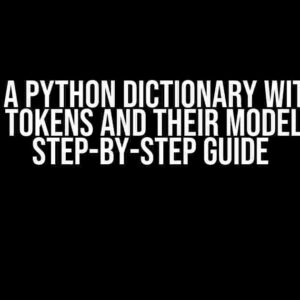Are you excited to dive into the world of machine learning with PyCaret, only to be greeted by a frustrating error message? You’re not alone! In this article, we’ll delve into the issue of PyCaret creating an API that can’t run due to Pydantic throwing an error. Don’t worry; we’ve got you covered with step-by-step solutions to get you back on track.
What’s PyCaret, and Why Should I Care?
PyCaret is an open-source, low-code machine learning library in Python that enables users to build, train, and deploy models quickly and efficiently. With its simple and intuitive interface, PyCaret is perfect for beginners and experienced practitioners alike. But, like with any powerful tool, there can be hiccups along the way.
The Error in Question: Pydantic Throws an Error
When you try to create an API using PyCaret, you might encounter an error message similar to this:
pydantic.error_wrappers.ValidationError: 1 validation error for API
path
value is not a valid path (type=type_error.path)This error occurs when PyCaret tries to create an API and Pydantic, a Python library used for data parsing and validation, throws an error. But fear not, we’ll guide you through the troubleshooting process to resolve this issue.
Troubleshooting Steps
Before we dive into the solutions, make sure you have the latest versions of PyCaret and Pydantic installed. You can check by running:
pip install --upgrade pycaret pydanticNow, let’s get started!
Step 1: Check Your Python Version
Pydantic requires Python 3.7 or later. Ensure you’re running a compatible version by checking your Python version:
python --versionIf you’re running an earlier version, upgrade to a compatible one.
Step 2: Verify Your PyCaret Installation
Double-check that PyCaret is installed correctly by running:
pip show pycaretIf PyCaret is not installed, install it using:
pip install pycaretStep 3: Review Your API Creation Code
Take a closer look at the code used to create the API. Ensure that you’re following the correct syntax and structure. Here’s an example of how you can create a simple API using PyCaret:
import pycaret.classification as clf
# Load your dataset
from pycaret.datasets import get_data
data = get_data('credit')
# Create a classification experiment
experiment = clf.setup(data, target='Class')
# Create the API
api = clf.create_api(experiment, 'my_api')Make sure you’ve correctly imported the necessary modules and defined the experiment and API correctly.
Step 4: Check for Incompatible Modules
Incompatible modules can cause issues with PyCaret and Pydantic. Check if you have any conflicting libraries installed. For example, if you’re using the `fastapi` library, it might be causing conflicts. Try uninstalling it and then retry creating the API:
pip uninstall fastapiStep 5: Update Pydantic
As a last resort, try updating Pydantic to the latest version:
pip install --upgrade pydanticThis should resolve any issues related to Pydantic.
Conclusion
By following these troubleshooting steps, you should be able to resolve the Pydantic error and successfully create an API using PyCaret. Remember to always check your Python version, PyCaret installation, and API creation code. If you’re still encountering issues, try checking for incompatible modules or updating Pydantic.
Frequently Asked Questions
We’ve got some common questions and answers to help you further:
| Question | Answer |
|---|---|
| What is PyCaret? | PyCaret is an open-source, low-code machine learning library in Python. |
| What is Pydantic? | Pydantic is a Python library used for data parsing and validation. |
| Why does PyCaret throw a Pydantic error? | PyCaret throwing a Pydantic error can be due to various reasons, including incompatible module versions, incorrect API creation code, or outdated Python versions. |
| How do I update PyCaret? | You can update PyCaret using `pip install –upgrade pycaret`. |
| Is PyCaret suitable for beginners? | Yes, PyCaret is designed to be user-friendly and accessible to beginners, making it an excellent choice for those new to machine learning. |
Additional Resources
Need more help or want to explore PyCaret further? Here are some additional resources:
With these troubleshooting steps and resources, you should be well on your way to creating a successful API using PyCaret. Happy coding!
Frequently Asked Question
Get answers to the most common issues with Pycaret’s API and Pydantic errors!
Why does Pycaret’s API throw an error when I try to run it?
This error usually occurs when there’s a version conflict between Pycaret and Pydantic. Make sure you’re running the latest version of both libraries. Try updating Pycaret using `pip install –upgrade pycaret` and Pydantic using `pip install –upgrade pydantic`. If the issue persists, try downgrading Pydantic to a compatible version.
What’s the deal with Pydantic’s error? Is it Pycaret’s fault?
Not entirely! Pydantic is a separate library used by Pycaret for data modeling and validation. The error is likely due to Pydantic’s strict type checking, which can sometimes clash with Pycaret’s dynamic typing. However, the Pycaret team is working hard to ensure compatibility and resolve any issues that may arise.
How do I troubleshoot the error and find the root cause?
To troubleshoot the error, try enabling debug logging in Pycaret by setting `log_level=’DEBUG’` when initializing the API. This will provide more detailed error messages and help you identify the root cause. You can also try inspecting the data being passed to Pydantic to ensure it meets the expected type and format.
Can I contribute to fixing this issue or providing a patch?
Absolutely! Pycaret is an open-source project, and the team welcomes contributions from the community. If you have a fix or a patch, submit a pull request on GitHub, and the maintainers will review and merge it. You can also report the issue and provide details about your environment and error message to help the team reproduce and fix the issue.
What’s the plan to prevent similar errors in the future?
The Pycaret team is committed to ensuring compatibility with Pydantic and other dependencies. They’re working on implementing more robust testing and CI/CD pipelines to catch version conflicts and type checking issues earlier in the development process. Additionally, they’re exploring ways to improve error handling and provide more informative error messages to help users troubleshoot issues more efficiently.




